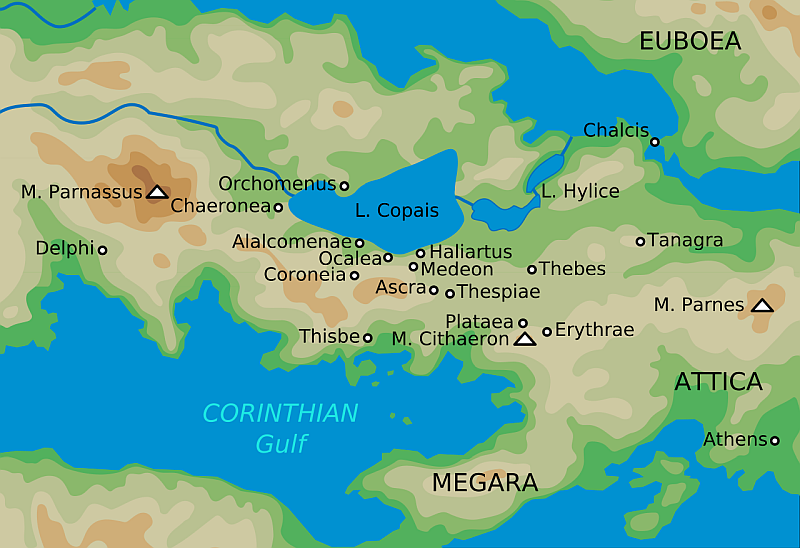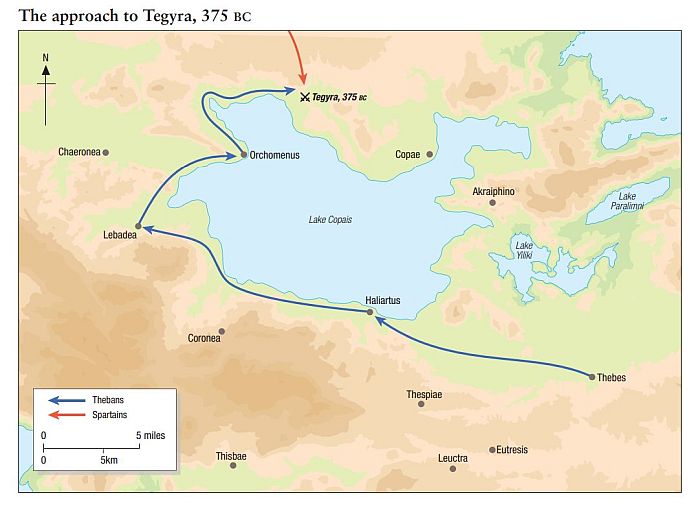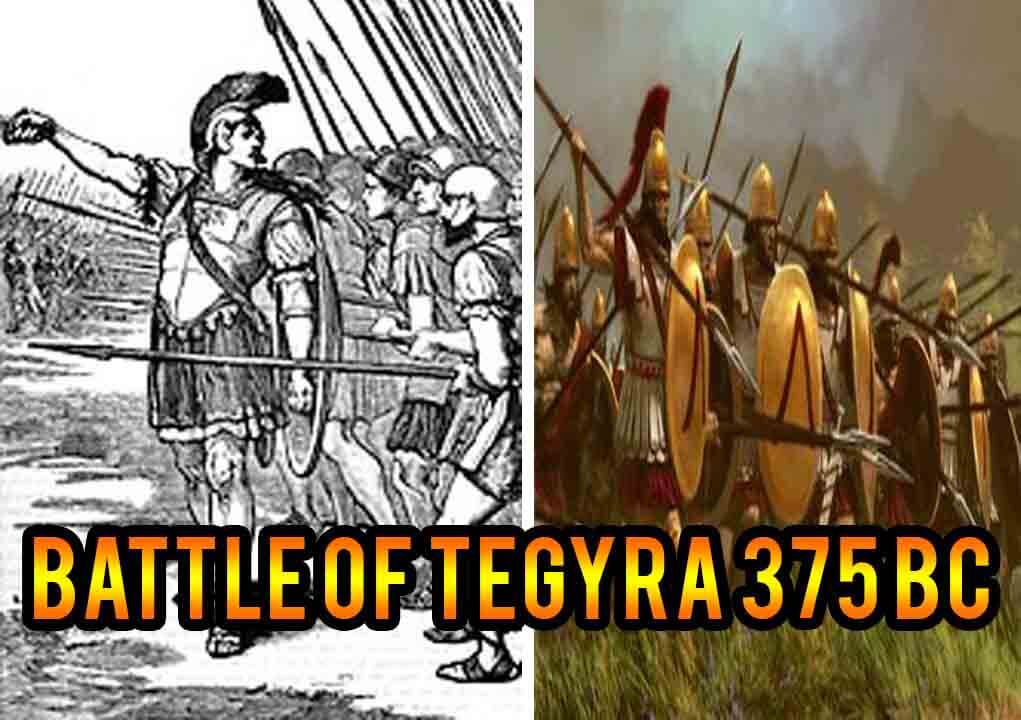Opposing forces: Thebans vs Spartans
Theban commander: Pelopidas.
Spartan commanders: Gorgoleon and Theopompus.
Estimated Strenght
Thebans: around 500 troops, some sources speak about 300 infantry and 200 cavalry units.
Spartans: depending on the ancient sources, between 1200-1800 troops.
Causes:
-the liberation of Thebes from Spartan rule.
–failure of previous Spartan expeditions into Beotia.
-Pelopidas ambition to occupy the last Spartan-controlled city in Beotia.
I. Introduction
For many, the Battle of Tegyra(375 BC), a clash between the Theban forces led by Pelopidas and a superior Spartan force, might seem like a minor skirmish in history, without any major significance.
The Battle of Tegyra, though not impressive because of the size of the forces involved, did provide a valuable lesson; the myth of the invincibility of the Spartan forces was seriously shattered.
Another important consequence of this battle was that it open the way for the decisive Theban victory at Leuctra(371 BC).
The Battle of Tegyra marks the beginning of the downfall of the Spartan Hegemony over Ancient Greece.
II. Historical Context

It is the year 382 BC, Thebes, once the most important city of the former Beotian League was under the control of a pro-Spartan government.
Many Theban leaders who wanted to liberate the city and reform the Beotian League choose to flee to Athens and seek the right moment to take revenge.
This moment would arrive in the year 378 BC, when Pelopidas along with other 300 Theban exiles from Athens, stormed Thebes and expels the 1500-strong Spartan garrison.
Thebes was now once again a free city, and most importantly it was now a real threat to Spartan Supremacy.
This moment represents the start of a long and hard struggle, one that will shape the political landscape of Ancient Greece.
The Spartan Kings(Agesilaus II and Cleombrotus) anticipating the danger represented by a free city in Beotia attempted several times to regain military and political control but with no success.
Their minor military expeditions into Beotia failed to achieve any important results.
As a consequence of the failure of the Spartan expeditions, in the year 375 BC several other important cities from Beotia (Tanagra, Haliartus, Lebadea, Coronea) expelled their Spartan garrisons and joined Thebes.
Encouraged by these early successes against the Spartans, Pelopidas, now one of the leading figures of the rising Theban power, sets his eyes on Orchomenus, the only city in Beotia still under Spartan control.
III. Battle Timeline

Upon hearing that the Spartan garrison at Orchomenus left the city to fight in another battle, Pelopidas thinking that the city was undefended, quickly assembles a small raiding force.
According to most ancient sources, the approximate size was 300 Sacred Theban Hoplites and 200 cavalry units. (figure of 500 total men is given by Diodorus, Plutarch doesn’t provide an exact figure)
The small force quickly marches against the Spartan-controlled city of Orchomenus.
To the surprise of Pelopidas, the city was defended by another garrison, because the Spartans decided to send additional reinforcements.
Not expecting resistance and realizing that he couldn’t quickly conquer the city(most probably due to the lack of siege weapons) Pelopidas decides to retreat to Thebes.
Instead of taking the same route, the small Theban force led by Pelopidas takes a detour and uses a land route North of the Lake of Copais.
Without knowing Pelopidas and his force would march straight in front of the Spartan garrison, the same Spartan force which had gone to Locris and was now returning to Orchomenos by the very road of Tegyra.
Neither the Thebans nor the Spartans were aware of the presence of their opponents.
Some marched to the North, others to the South. Pelopidas became aware of the presence of the Spartans when they entered the strait between the marshes of Lake Kopaida, the sanctuary of Apollo, and Mount Delius.
The clash between the two forces was now inevitable.
We know from Plutarch that both sides were surprised by this sudden encounter, so it is most likely that there were no clear strategies made before the battle.
Now let us take a look at the size of the forces involved in this skirmish.
We know from Diodorus that Pelopidas small force numbered about 500 soldiers(he doesn’t mention if infantry or cavalry).
Plutarch doesn’t mention the size of Pelopidas force, but he mentions that the Theban commander took with him the Sacred Band and some cavalry.
What about the strength of the Spartan garrison from Locris?
We know from Plutarch’s description of the battle, that the Spartans were organized into 2 morais.
The exact size of a morai unit differs from one ancient source to another.
See below Plutarch’s own words about the strength of a single Spartan morai unit at Tegyra:
“…according to Ephorus, of seven hundred, according to Callisthenes, of nine hundred, according to certain other writers, among whom is Polybius.”
Basically, Pelopidas army was outnumbered in the best case scenario by a ratio of 2:1 and in the worst case scenario even 3:1(total Spartan strength between 1200-1800 units)
Now returning to the battle itself, on the day of the decisive clash, Plutarch mentions an interesting episode.
A messenger arrives in the Theban camp and alerts Pelopidas about the nearby Spartan presence, saying: ” We have fallen into the hands of the enemy”.
Pelopidas fearless and clever reply was:” And why shouldn’t they fall into yours?“
Without hesitation, the Theban commander rallies his small force and marches straight into the Spartan phalanx.
Some may wonder, why did Pelopidas choose to do battle instead of simply retreating?
The answer is that the Theban commander might have been left without any options.
Possibly he had the Spartan garrison from Orchomenus on his back and with the enemy army in front of him also, Pelopidas had to act quickly and decisively.
If the Spartan army and the garrison from Orchomenus joined forces, it would’ve been total annihilation for both Pelopidas and the Theban army.
It seems that the Spartans’ polemarchs, Gorgoleon and Theopombus, thought that their discipline and numerical superiority would be enough to crush Pelopidas small force.
How the actual battle was fought between the two forces is still a matter of debate, because the historical sources( Plutarch, Diodorus, Xenophon) don’t mention the exact actions/locations and maneuvers of the military commanders/ soldiers who participated in this clash.
Modern historians are split between 2 plausible scenarios about the progress of the battle.
Scenario 1:
While the Theban cavalry is used to delay the advance of the Spartan flanks and prevent any encirclement. Pelopidas with his elite infantry attacked the Spartan’s right flank.
Pelopidas with the Sacred Band attacks the right flank of the Spartan force, quickly overwhelms it, and the Spartan commanders are eliminated. As a consequence, the leaderless Spartan decides to open a path for the Theban army to retreat.
Pelopidas seizes the initiative and instead of retreating through the open path opened by the Spartans, he rushes with his force against their flanks.
An important mention, in this chain of events the Theban cavalry, like in scenario 2 had the role to delay the Spartan flanks, preventing an encirclement of the Sacred Band.
Scenario 2:
Pelopidas and the Theban Infantry storm the center of the Spartan army, while the Theban cavalry is used to distract the Spartan flanks.
Pelopidas manages because of the ingenious deployment of the Theban infantry(he most likely copied a strategy used by Pagondas during the Battle of Delium) to break the Spartan center.
With the collapse of the Spartan center, the Theban infantry quickly attacks the Spartan flanks which were at the same time harassed by the Theban cavalry.
Whatever the real chain of events is the outcome of the battle remains the same.
Pelopidas tries to pursue the retreating Spartans but with partial success because some of the retreating Spartan units manage to link up with their garrison from Orchomenos.
Nevertheless, Battle Tegyra is a Theban victory.
At the end of the day, the small Theban force effectively controlled the entire battlefield and despite all the odds it achieved the unthinkable.
Additional notes about the battle:
- some historians tend to overestimate the role of the Theban cavalry citing passages from Plutarch about the battle. Plutarch mentions the charge of the Theban cavalry against the Spartan hoplites but doesn’t clearly mention their fate.
- it is more likely that the Theban cavalry played a secondary role in this battle(flanking or delaying force)
- the actual location of the Spartan commanders during the battle is not well known(some argue for the Right flank, others for the Center).
- the Theban victory wasn’t fully exploited by Pelopidas because it seems that the Spartans who fled the battlefield managed to link up with the garrison from Orchomenos.
- The ancient sources do not mention the losses on either side. But they report that both Spartan warlords fell in the battle, which suggests that the Spartan losses would have been quite significant. But beyond the losses, what was mortally wounded in Tegira was the Spartan prestige.
IV. Consequences and importance
–survival of Pelopidas force
-a short-term boost for the Theban army morale
-it marks the beginning of the Rise of Thebes as a Hegemon over Greece
-serious dent for the Myth of the Spartan invincibility on the battlefield.
-it proved to the other Greek cities that there were other elite warriors even outside Sparta.
Even if the numbers involved in this battle were very small, the Battle of Tegyra effectively demolished the Myth of the Spartan army’s invincibility on the battlefield.
It was one of the rare occasions in history when a numerically superior Spartan force was effectively crushed by his opponents.
The Spartans in history were defeated on other occasions(see the Battles of Pylos and Sphacteria), but there it was about the contribution of the Athenian navy to the overall outcome.
At Tegyra, the Thebans defeated and obtained victory only with ground forces, and more importantly while being outnumbered by the Spartans.
Diodorus Siculus writes about the Theban victory at Tegyra:
“the first occasion when on account of the importance of the victory the Thebans erected a trophy over the Lacedaemonians.”
The Battle of Tegyra represents in the short term a morale boost for the Theban army led by both Pelopidas and his close friend Epaminondas.
In the long term, the Battle of Tegyra prepared the ground for another decisive clash in history, the Battle of Leuctra(371 BC).
Even Plutarch wrote that the Battle of Tegyra represents “a prelude to Leuctra”.
The Battles of Tegyra and Leuctra, together represent the beginning of the end for the Spartan Hegemony over Greece.
V. Sources and further reading about the Battle of Tegyra
Plutarch, V: Agesilaus and Pompey. Pelopidas and Marcellus (Loeb Classical Library®) (Volume V), translated by Bernadotte Perrin, Harvard University Press.
Diodorus Siculus, Library, 15.81.2
Murray Dahm, Leuctra 371 The Destruction of the Spartan Dominance, Osprey Publishing; 1st edition
